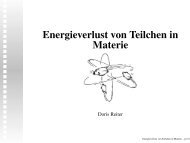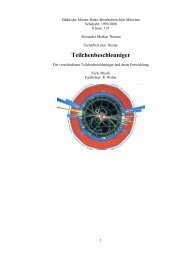The FEE Server Control Engine of the ALICE-TRD - Westfälische ...
The FEE Server Control Engine of the ALICE-TRD - Westfälische ...
The FEE Server Control Engine of the ALICE-TRD - Westfälische ...
You also want an ePaper? Increase the reach of your titles
YUMPU automatically turns print PDFs into web optimized ePapers that Google loves.
ADC difference (a.u.)<br />
120<br />
100<br />
80<br />
60<br />
40<br />
20<br />
6 Temperature Monitoring <strong>of</strong> <strong>the</strong> Front End Readout Electronics<br />
0<br />
0 20 40 60 80 100 120<br />
time (min)<br />
Figure 6.5: MCM temperature sensor data with fitted functions <strong>of</strong> type f (x) = a1 · e b 1·(x−x0) + a2 ·<br />
e b2·(x−x0) + d (solid lines). Each section was fitted separately. <strong>The</strong> data are <strong>the</strong> same<br />
already shown in figure 6.3.<br />
<strong>the</strong> slope <strong>of</strong> <strong>the</strong> curve. Parameter c determines <strong>the</strong> final value <strong>of</strong> <strong>the</strong> function for x → ∞<br />
since b < 0 for all fits in this chapter.<br />
Figure 6.6 shows <strong>the</strong> fitted curves. But for a cooling overview three fit parameters<br />
for each MCM and each section are still too many. A formula is required which takes <strong>the</strong><br />
nine fit parameters as inputs and gives just one number (’score’) which indicate how well<br />
cooled an MCM is.<br />
To deduce such a formula, <strong>the</strong> temperature curves <strong>of</strong> each MCM in two complete layers<br />
were fitted. One layer had active cooling and <strong>the</strong> o<strong>the</strong>r one was not cooled. <strong>The</strong><br />
distribution <strong>of</strong> <strong>the</strong> obtained fit parameters are shown in figure 6.7. In <strong>the</strong> left column<br />
<strong>the</strong> magnitude is shown as a function <strong>of</strong> <strong>the</strong> slope and in <strong>the</strong> right column <strong>the</strong> magnitude<br />
is shown as a function <strong>of</strong> <strong>the</strong> limit. <strong>The</strong> linear dependence between <strong>the</strong> magnitude<br />
(parameter a) and <strong>the</strong> limit (parameter d) is expected.<br />
As described above, x0 is chosen to fulfill x − x0 = 0 for <strong>the</strong> first x <strong>of</strong> each section.<br />
For this value equation 6.2 simplifies to f (x) = a + c. <strong>The</strong>refore a linear dependence<br />
between a and c just means that f (x) has <strong>the</strong> same value for all MCMs at <strong>the</strong> beginning<br />
<strong>of</strong> <strong>the</strong> region. In particular <strong>the</strong> fit parameters for region one have to show this linear<br />
dependency since <strong>the</strong> first MCM temperature sensor reading <strong>of</strong> all MCMs was set to zero<br />
(see begin <strong>of</strong> this section).<br />
<strong>The</strong> plots in figure 6.7 show that uncooled MCMs always have a larger absolute value<br />
<strong>of</strong> a · b. After some tests it was decided to use <strong>the</strong> following formula to calculate <strong>the</strong><br />
’score’:<br />
score = 50 · a1 · b1 + 10 · a2 · b2 − 20 · a3 · b3. (6.3)<br />
a1 and b1 are <strong>the</strong> fit parameters obtained by fitting <strong>the</strong> function 6.2 in region 1, a2 and<br />
b2 are <strong>the</strong> fit parameters from region 2 and a3 and b3 are <strong>the</strong> fit parameters from region<br />
83







